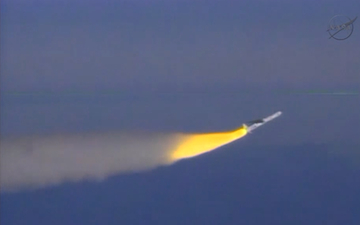Pegasus Delivers IRIS to Orbit
Orbital Sciences Press Release:
Orbital Sciences Corporation (NYSE: ORB) announced today that its Pegasus® rocket successfully launched the Interface Region Imaging Spectrograph (IRIS) satellite for the National Aeronautics and Space Administration (NASA). The IRIS spacecraft was deployed into its targeted orbit approximately 400 miles above the Earth and early results confirm that the satellite is operating as anticipated at this stage of its mission.
The launch of the Pegasus rocket originated from Vandenberg Air Force Base (VAFB), California when Orbital’s’ L-1011 “Stargazer” carrier aircraft took off from the airfield at approximately 6:30 p.m. (PDT). Following a one-hour preplanned positioning flight, the Pegasus rocket was released at approximately 40,000 feet from Orbital’s L-1011 “Stargazer” carrier aircraft at 7:27 p.m. (PDT). After a 13-minute powered flight sequence, Pegasus launched the 440-pound IRIS satellite into its polar, sun-synchronous Earth orbit.
“The Pegasus rocket carried out another successful mission for NASA today, extending its record of consecutive successful missions to 28 over a 16-year period,” said Mr. Ron Grabe, Orbital’s Executive Vice President and General Manager of its Launch Systems Group. “We are proud of our launch team and are pleased to have contributed to a successful beginning of this important NASA heliophysics science mission.”
The launch of IRIS marks the 45th overall mission for the Pegasus program. Its launch history now includes 42 launches to orbit, which collectively have deployed more than 80 satellites for Earth and space science missions overseen by NASA; military and technology demonstration spacecraft for the U.S. Department of Defense; and communications and imaging satellites for commercial customers. Pegasus technology has also been used to launch three hypersonic flight experiments in Earth’s stratosphere for NASA’s HyperX program.
IRIS is a NASA Small Explorer (SMEX) mission designed to observe how solar material moves, gathers energy and heats up as it travels through a little-understood region in the Sun’s lower atmosphere. This interface region between the Sun’s photosphere and corona powers its dynamic million-degree atmosphere and drives the solar wind. The interface region also is where most of the Sun’s ultraviolet emission is generated that impacts the near-Earth space environment and Earth’s climate.


